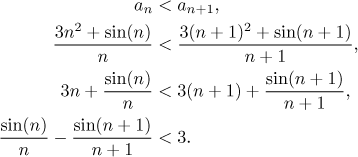Problem: Investigate boundedness and monotonicity of
![]()
Solution:
We try to calculate the first few terms:
Proof of boundedness from below:
We always have
Now we will show that this sequence tends to infinity, hence it cannot be bounded from above, consequently it is also not bounded. We will prove it by comparison, see for instance Methods Survey - Limits - Comparison and oscillation.
![]()
Proof of monotonicity: We will test the inequality for an increasing sequence.

Is this inequality true? Now it is not so clear, but let's see: The sine is always at most 1, so we can estimate
![]()
Thus the last inequality above was true, therefore also the first one. We proved that the given sequence is increasing.
Could we use methods from function calculus? We can try. We will investigate
the function
 (see Theory - Limits -
Sequences and functions). We find the derivative:
(see Theory - Limits -
Sequences and functions). We find the derivative:
![]()
Just like before, from boundedness of sine and cosine by 1 we conclude that
the derivative is at least 1 for
Remark: An experienced problem solver would prefer to work with the expression
calculations are then a bit easier (the derivative by quite a bit).